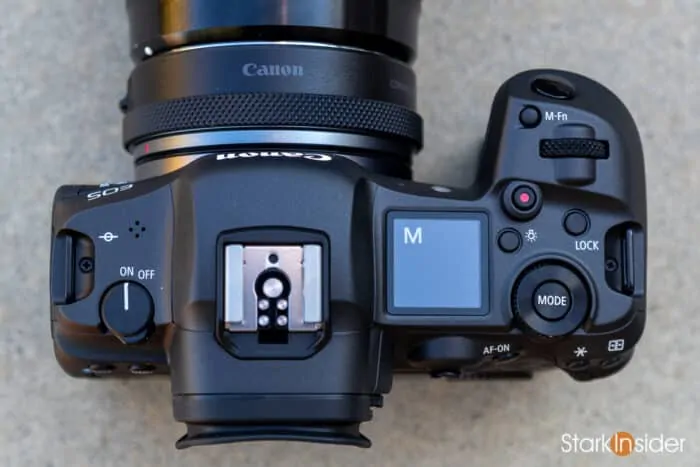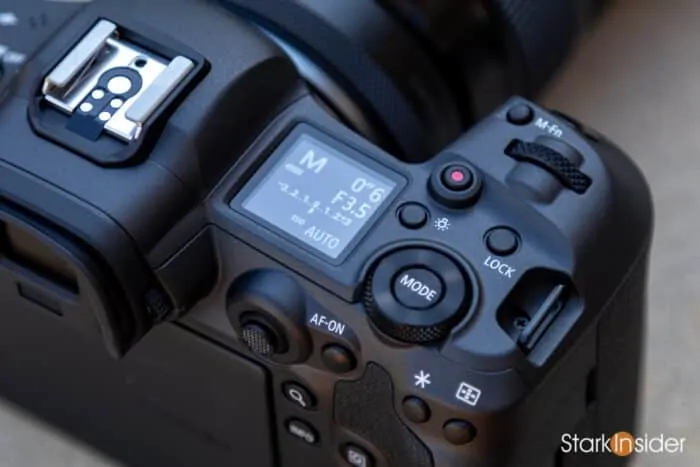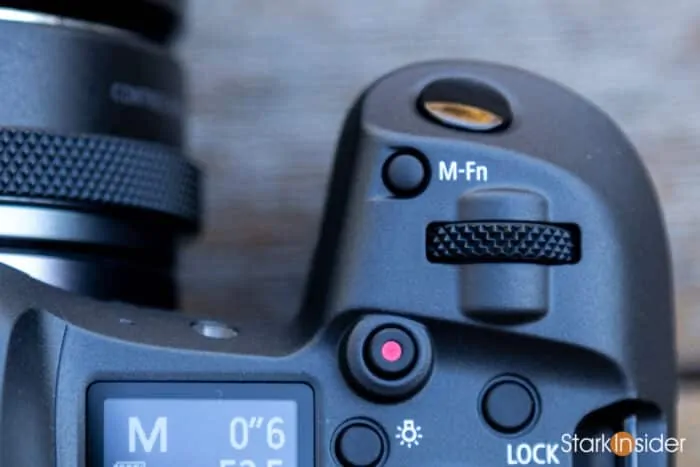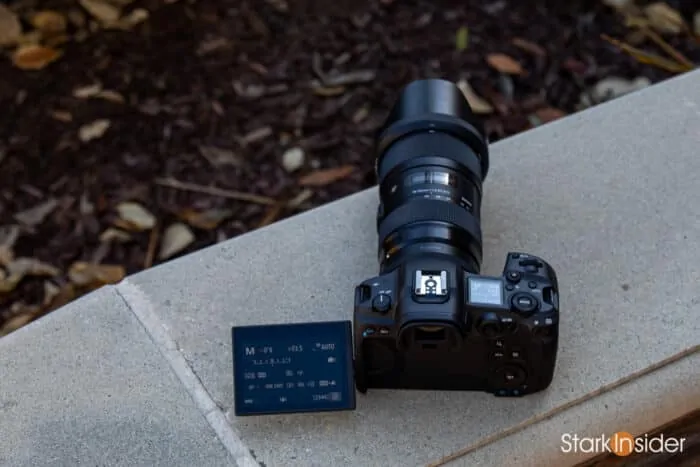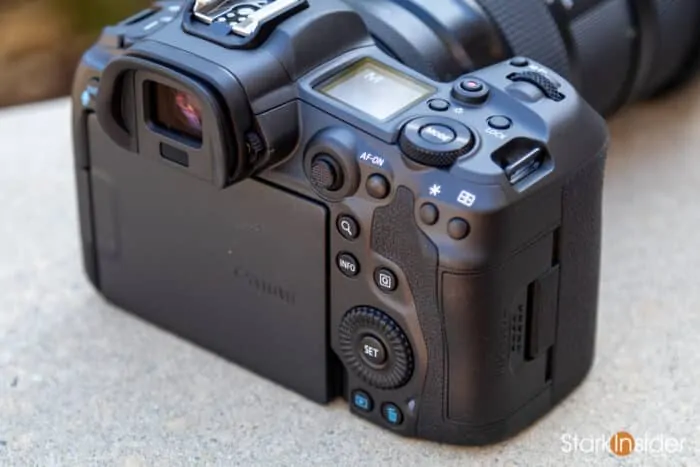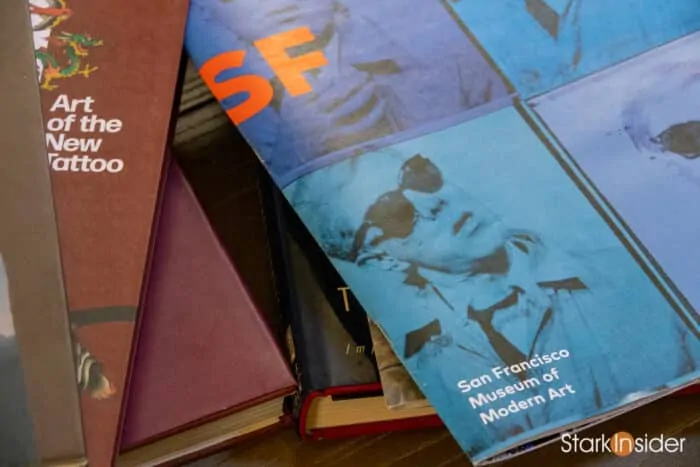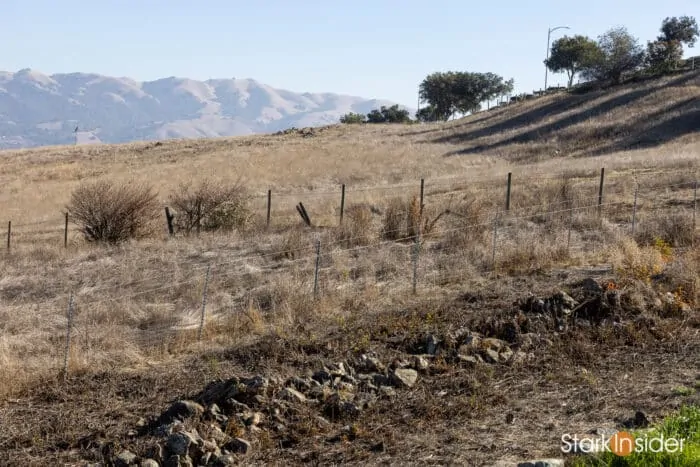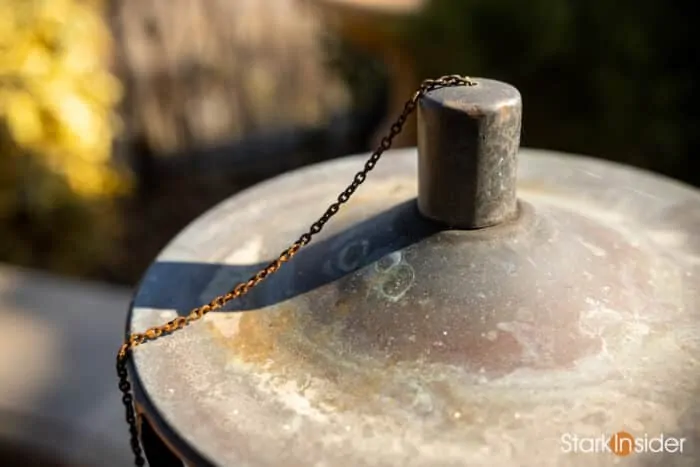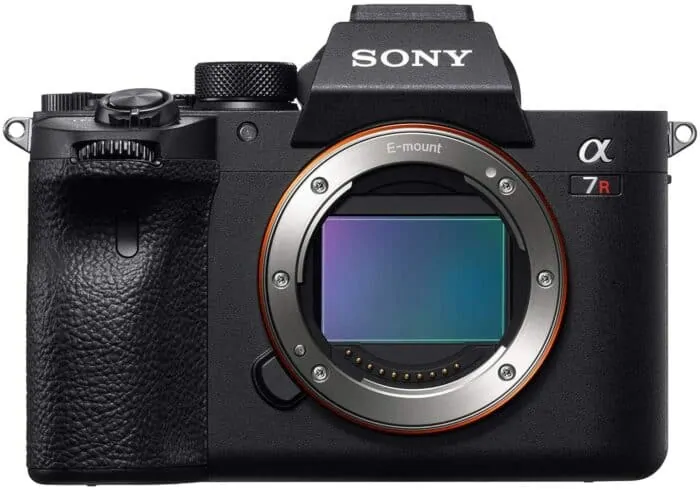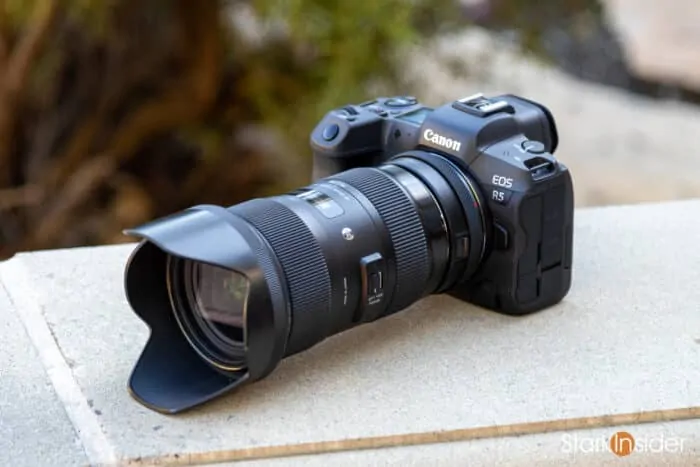Update: added test photos and a comparison of Canon EOS R5 competition from Sony, Nikon and Panasonic.
Canon is on a roll. So much so that we just can’t help but call it: the Canon EOS R5 is the best full-frame camera of the year.
No question, there’s plenty of competition in the mirrorless full-frame market. Recent models from Panasonic, Sony, Nikon and Canon have crowded the space and given consumers solid choices from budget friendly options such as the Canon EOS RP (Only $899 USD via Amazon Cyber Monday Deal) all the way up to flagships such as the new Sony a7 IV ($2,998 via Amazon Cyber Monday Deal) and Panasonic SIR ($3,698 via Amazon). To name but a few.
But if what you’re looking for is a true hybrid mirrorless, meaning a camera body that is equally adept at taking high resolution photos as it is taking high resolution 4K video then the R5 truly delivers the best of worlds. You can capture beautiful 45MP images. And you can also capture detailed 4K (and 8K) video, even in Canon’s famed C-Log picture profile if you’re planning on doing advanced color grading during post production.
Canon EOS R5: Table of Contents
Canon EOS R5: Ergonomics
Everything feels just right. Nothing fancy. Just right.
In a brief tour of the R5 — a camera that has so many reviews it boggle the mind (just Google it and you’ll see) — beyond all the technical specs let’s start with ergonomics.
Here, once again, Canon is simply top notch in its approach. A long history of digital cameras including the iconic and revolutionary EOS 5D II, and a long line-up of consumer-friendly models including Rebels such as the T2i (an early favorite) and recent EOS models such as the 80D and 90D have proven Canon’s ability to get just about everything right when it comes to the body design.
On the R5 ergonomics reign supreme.
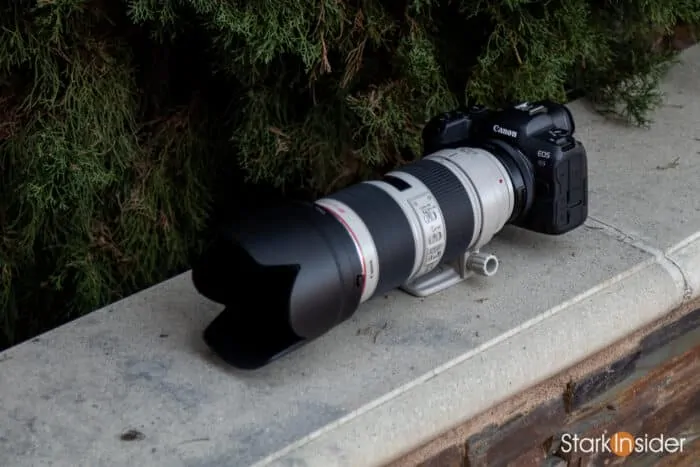
A simple power switch sits on the left of the top plate, nothing more. A minimalist philosophy I can appreciate. Why complicate the basics?
Over on the right side you find the typical array of controls found on most DSLR and mirrorless models. 5 buttons in total including the shutter release and mode buttons and a forward dial and a rear dial. Two of them are smaller ones you won’t likely use often: one to turn on the LCD light and another to its right to lock everything so not accidental changes happen in challenging shooting conditions.
What Canon does here that is special (though not entire unique) is implements a design that lends itself well to muscle memory. Each button has a slightly different feeling to it. M-Fn, for instance, is tiny and sits right where you can easily tap it with your index finger. On the other hand the red record button sits further back and on a slightly lower plane with a button that is less “clicky” and more “springy.” So you know the difference without ever having to look down.
Many purists might miss the tradition mode dial. With the R5 Canon opted for a LCD/button combination when selecting the mode, so you use a dial and look to the mode setting on a screen to confirm. In my shooting and handling tests I found no issues here and like the clean design. In addition, because of this approach Canon could foreseeably change and enhance this functionality with future firmware updates, something that is not possible with a fixed button and modes physically etched atop. An interesting possibility to consider.
Canon EOS R5:
Key Specs
- 45MP Full-Frame CMOS Sensor
- DIGIC X Image Processor
- Lens mount: RF
- 8K30 Raw and 4K120 10-Bit (4:2:2) Internal Video
- Sensor-Shift 5-Axis Image Stabilization
- Dual Pixel AF II (available in all 4K and 8K video modes) — 100% area with 1,053 AF areas
- High-speed continuous shooting of up to 12 fps with Mechanical Shutter and up to 20 fps electronic (silent) shutter
- Subject tracking of people and animals using deep learning technology
- WiFi (2.4/5 GHz) and Bluetooth
- Dual memory card slots: CFexpress and UHS-II SD
- 0.5-inch 5.76 million dot OLED EVF
- 3.15-inch, 2.1MP fully articulating LCD
- Weather sealing to Canon EOS 5D IV standards (per Canon)
- Weight: Approx. 1.63 lbs.
- Retail: $3,899 USD (Amazon)
On the back you’ll find what Canon calls the “Main Dial” which can be used in tandem with the top plate’s two “Quick Main Dials” as mentioned above. As you might expect you can use the three in all sorts of custom ways to control shutter speed, aperture and ISO.
Yes, the R5 has a flippy screen.
No surprise. Most Canon DSLR and mirrorless bodies do these days (and for as long as I recall, way back to even the T2i). It’s fully articulating so bloggers and content creators with big budgets and aspirations will find no faults when it comes to creating selfie-centric content for YouTube. At 3.15-inches there’s plenty of space on the LCD screen for the image preview and surrounding information.
Unlike the earlier EOS R, there’s no multi-function slider. Thankfully. In my brief experience with an R which I rented and walked around San Francisco a few years back — a veritable lifetime ago — the slider was a finicky thing. Though over time I suppose I’d come to like it. Still, I appreciate that the R5 instead has a trusty joystick in its place. You can use that for auto-focus placement, but mostly you’ll use it for navigating the excellent menu system.
Canon EOS R5: Auto-Focus
DPAF II is here and it remains the best AF system on the market.
When it comes to AF there’s just no beating Canon’s famed DPAF (Dual Pixel Auto Focus). Focusing on the R5 is incredibly responsive and accurate. Even in low light in my tests. Subject tracking, faces, people and animals for instance is about as you’d come to expect from a system that has been refined over the last seven years or so. For photos and videos DPAF really is the so-called secret sauce.
Recently I tested the Panasonic Lumix S5, a solid video-centric full-frame camera. At $2,000 USD it falls mid-range in today’s full-frame market. I was mostly impressed.
The S5 felt like a natural upgrade from the Lumix GH5. For video it’s fantastic. Typical Panasonic greatness. However, auto-focus performance for photos was poor. I’d have to continually half-press the shutter to lock in focus during the exact same photo tests where the R5 (and my old 80D) would get the job done with no delay or struggle. Here, I really appreciate the idea of DPAF and phase detection systems versus contrast-based systems. You want the former if accurate is AF is important. Still if you’re focused on video projects then the S5 could be an ideal choice. AF aside it’s a killer camera for the price.
Canon generously provides 8 tracking options for the R5:
- Face + Tracking
- Spot AF
- 1-point AF
- Expand AF area
- Expand AF area: Around
- Zone AF
- Large Zone AF: Vertical
- Large Zone AF: Horizontal
Suffice to say you’ll certainly have what you need when it comes to auto-focus. Yes, for newbies to the Canon world there’s going to be some experimentation and learning needed. Menu systems on these cameras are deep, with lots of customization options. Those coming from a Canon RF-mount mirrorless or even the older DSLRs such as the 5D IV or 6D should be up-and-running quickly.
Canon EOS R5: Video
Outstanding video specs should more than satisfy most users.
Much has been written about the 8K headline grabbing capability of the R5. And I guess for some that ability will be nice to have, even if the feature has more to do with future-proofing than actual real-world usability. I don’t think many will be shooting hours upon hours of 8K video. Practically it’s expensive, slows down workflow with unwieldy transfer times and really doesn’t offer more than what we all get with 4K. Which is what I’d recommend: stick with 4K video recording for most of your projects.
Essentially there are no compromises with 4K.
At 4K on the R5 you can shoot up to 120fps in full 4:2:2 H.265 with Canon Log (C-Log).
Essentially there are no compromises with 4K. All the right boxes are ticked. Better yet, DPAF is available in all these modes.
I can’t think of anything to complain about here. I have yet to shoot a full-on short film project or experimental bit for Stark Insider. And travel has not been an option obviously. So I will need to wait to fully test the R5 on the video/filmmaking battlefield to see how it truly performs in a pressure cooker.
Canon EOS R5: Photos
45MP and accurate and rapid AF.
Note: All of the above photos were taken with a Canon EOS R5 with a Sigma ART 18-35mm f/1.8 and Canon 70-200mm f/2.8 lens. Photos were processed in Adobe Lightroom for white-balance, saturation and other minor tweaks. No filters were applied. Don’t worry. I’m not holding my breath for that photographer of the year award…
On the photography side with the R5 of course you get generous detail thanks to the 45MP image sensor. I shoot a lot of artwork. My spouse is an avid oil painter. I didn’t really consider myself a pixel peeper until a few years back I started taking stills of her work. We look for several things. Color accuracy is paramount. Then the detail/sharpness (I use Lightroom to zoom in and assess quality). And finally resolution — we need as much as possible so we can blow up posters or reprints or images suitable for magazines and books, etc. All the typical stuff expected when photographing artwork (and, by the way, I find it extremely challenging, especially oil-based paintings).
Before the R5 I used an EOS 80D to shoot her paintings. It was okay. Problems surfaced when you zoomed in for closeups. Softness was prevalent. On the other hand I’d get much cleaner and sharper results with a Sony mirrorless. Yet, it struggled with color accuracy.
Thankfully the R5 nails both. Image quality is both sharp and color accurate. Well, in any case that’s my use case.
Others will be more interested in high speed shutter (12fps mechanical, 20fps electronic). IBIS. Low light performance. Or time lapse. If you’re still researching the camera market and trying to make a decision I highly recommend digging into the DPreview R5 review (91% Gold Award). As always it’s comprehensive, both on the photo and video side.
One quick note regarding full-frame and video. For me, I prefer the look of Super 35. Film approximation is always my goal with our Stark Insider videos (e.g. Iceland or Crazy or Die). Grain is king. APS-C tends to achieve that feeling better in my experience. Full-frame, on the other hand, seems to be more naturalistic (whatever that means). For real world stuff the R5 could be the better choice. For filmmaking, though, I prefer video-centric cameras like the GH5 (and new S5), RED (DSMC2) cinema cameras, Sony (a7 S III), and Blackmagic.
Canon EOS R5: Problems and Nitpicks?
This is as perfect a camera I have ever tested, but…
By now you’re likely under the impression I’ve been drinking too much Canon Kool-Aid. Yet, the R5 truly is that good. Otherwise I’d be pointing out all its flaws. There are, however, a few minor niggles worth pointing out.
The first applies to the R5, but also to pretty much any modern day DSLR or mirrorless camera, full-frame, APS-C or otherwise.
And that is: the user interface must improve.
We live in the era of the smartphone and, increasingly, computational photography. The iPhone camera and others from Samsung, Google, etc. is getting better every year. And along with that we smartphone users — all of us — enjoy amazing UI design on apps we use everyday. Switching from an iPhone to my 80D or even the R5 can result in whiplash. Camera interfaces still feel quite 1990s-ish. Even though the R5 menu is easy to navigate, it’s nowhere near the smartphone standard we’re accustomed to now in the 21st century.
In addition, software is increasingly being leveraged to help smartphone cameras achieve pretty amazing things (e.g. machine learning and adjustable post-photo focus). When will these features and design philosophy make their way over to Japan and the traditional camera makers like Canon, Sony, Panasonic and Sony? If I were them I’d be bulking up my UI teams; aggressively hire some talent from Silicon Valley, those who have worked on leading edge touch interfaces and apps.
I should note the closest I’ve seen any camera company come close to an elegant, user friendly interface is Blackmagic Design from Australia. Something for the competition to consider.
If you’re buying into the new RF-based cameras from Canon (R, RP, R5, R6) know that RF lenses are generally pricey, at least ones made by Canon. Long-time Canon shooters have an easy solution and it’s what I did: buy an EF/EF-S to RF adapter and use all your existing glass. Works perfectly. Plus, I like the configurable control ring on the adapter.
Finally, the other possible negative thing to watch for with the R5 has been well documented, and that is overheating in 8K. I mostly shoot short clips so this isn’t a big deal. And, in any case, I’ll be shooting 4K. The bitrate is 470 Mbps for 4K UHD All-I 23.98fps on the R5 versus 1300 Mbps for 8K or 2600 Mbps for 8K Raw — memory card makers must love this marketing hype. Who in their right mind is going to shoot a 1-hour church service in 8K? Or 2-hour interview in 8K? Why? Why? Why?!!!!
Canon EOS R5: The Competition
In this premium niche market, Canon appeals to the true hybrid user.
Given the R5 costs $3,899 USD and sits in the high-res mirrorless class there’s not much choice in this space.
The most likely candidate would be the Sony a7R IV ($2,998 USD Cyber Monday Deal). I rented the a7 III a while back. An absolutely beautiful camera. Ergonomics not as good as Canon. In fact they’re quite Sony. Which is to say quirky. Performance wise, though, you might not be able to do better on the photo side. Video-wise the Canon is far more capable and, hence, is the better true hybrid and all-rounder.
Also consider the Nikon Z7 ($2,496). Those invested in Nikon glass will likely move in this direction. Why change systems unless you have a specific need?
And, finally, the Panasonic S1R ($3,697). Here Carey Rose of DPreview writes, “… the EOS R5 comes out on top for us because its autofocus system and burst speeds make it a more competent camera for sports and action overall, though the S1R does turn in a really solid hit rate, albeit at a more pedestrian 6fps maximum burst speed.”
I would be remiss if I didn’t also mention the R5’s baby brother, the Canon EOS R6 ($2,499 at Amazon Cyber Monday Deal). Not to be underestimated, especially for video-centric shooters. The image sensor, as expected, is a step down, to 20MP. But this is still a 4K full-frame camera with the aforementioned superb Dual Pixel AF II, dual memory slots, and IBIS all in a body that is identical to the R5. Sure, the EVF isn’t quite as good and — what to do — there’s no 8K video option. Need we remind ourselves that common sense prevails?
Canon EOS R5: Best Full-Frame Mirrorless Camera of the Year
The flagship price point can be a bitter pill to swallow, but the results are most definitely flagship worthy.
With the EOS R5 Canon has taken its recent mirrorless full-frame experience — notably the EOS R and RP — and dialed in a killer high-resolution body that should appeal equally to video shooters and photographers. And isn’t that the point of a hybrid? Yes, for pure video I’d probably steer Panasonic. But you’d lose AF performance for photography. With the a7S III you get incredible video specs, but you don’t get the megapixels needed for professional photography.
ALSO SEE: Top 10: Best DSLR & Mirrorless Cameras (December 2020)
That’s why the Canon EOS R5 is the Stark Insider pick for camera of the year, and the best all-around full-frame mirrorless option. Video. And photos. When it comes to the R5 you’re equipped to professionally handle either scenario to the highest possible standard. The flagship price point can be a bitter pill to swallow, but the results are most definitely flagship worthy.


